Hydrogen Production via Electrolysis of Wastewater
Abstract
1. Introduction
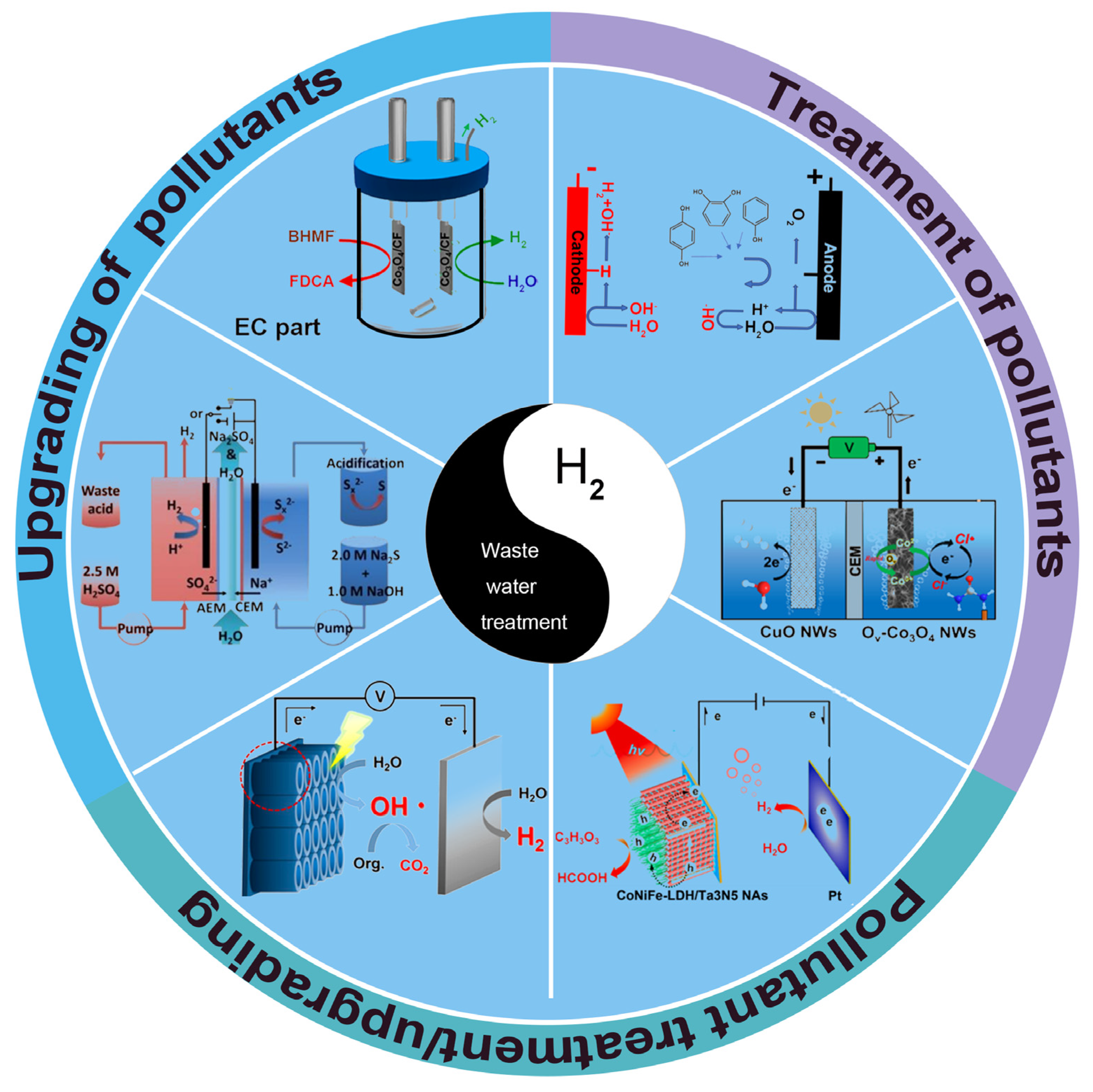
| Type of Cell | Cathodic Catalyst | Anodic Catalyst | Driving Voltage | Pollutants in Wastewater | Product | Ref. |
|---|---|---|---|---|---|---|
| Type I | Co-Mo2C | Co-Mo2C | 1.68 V (10 mA cm−2) | - | H2+O2 | [23] |
| CoBOx/NiSe | CoBOx/NiSe | 1.48 V (10 mA cm−2) | - | H2+O2 | [24] | |
| Ni5P4@NiCo2O4 | Ni5P4@NiCo2O4 | 1.65 V (100 mA cm−2) | - | H2+O2 | [25] | |
| Ni/Ni(OH)2 | Ni/Ni(OH)2 | 1.59 V (10 mA cm−2) | - | H2+O2 | [26] | |
| CoMoP/Ni3S2 | CoMoP/Ni3S2 | 1.54 V (10 mA cm−2) | - | H2+O2 | [27] | |
| (Ni-Fe)Sx/NiFe(OH)y | (Ni-Fe)Sx/NiFe(OH)y | 1.46 V (10 mA cm−2) | - | H2+O2 | [28] | |
| HOF-Co0.5Fe0.5/NF | HOF-Co0.5Fe0.5/NF | 1.36 V (10 mA cm−2) | - | H2+O2 | [29] | |
| NiCo foam | NiFe foam | 1.52 V (10 mA cm−2) | - | H2+O2 | [30] | |
| Mo–NiCoP | E-Mo–NiCoP | 1.61 V (10 mA cm−2) | - | H2+O2 | [31] | |
| F0.25C1CH/NF | F0.25C1CH/NF | 1.45 V | - | H2+O2 | [32] | |
| Type II | CoNi@CN-CoNiMoO) | CoNi@CN-CoNiMoO) | 1.58 V (500mA cm−2) | Urea | H2+NO2 | [33] |
| Fe@N-CNT/IF | IF | 1.09 V (20mA cm−2) | Organic and heavy metal | H2 | [34] | |
| CoP/TiM | CoP/TiM | 0.20 V (10mA cm−2) | Hydrazine | H2 | [35] | |
| Cu(II)-Co3O4 NWs | Cu(II)-Co3O4 NWs | - | Urea | H2+NO2 | [17] | |
| CuO | Ov-Co3O4 | - | Urea | H2+NO2 | [36] | |
| Type III | CoO@C/MXene/NF | CoS2@C/MXene/NF | 0.97 V | Sulfion | H2+S | [37] |
| CoNi@NG | CoNi@NG | 0.25 V | Sulfion | H2+S | [38] | |
| CC@N-CoP | CC@N-CoP | 0.89 V (10 mA cm−2) | Sulfion | H2+S | [39] | |
| WS2 | WS2 | 0.53 V | Sulfion | H2+S | [18] | |
| PdBi/NF | PdBi/NF | 1.02 V | Alcohol | H2+3-Hp | [40] | |
| Co3O4/CF | Co3O4/CF | 1.39 V (10 mA cm−2) | 2,5-bis(hydroxymethyl)furan | H2+FDCA | [19] | |
| Pt/C | Cu(OH)2/NF | 0.92 V (100 mA cm−2) | Glucose | H2+CHOCOOH | [41] | |
| Pt/C | Cu-Cu2O/CC | 0.59 V (10 mA cm−2) | Glycerol | H2+HCOOH | [42] | |
| CoNi0.25P/NF | CoNi0.25P/NF | 1.80 V (500 mA cm−2) | Polyethylene terephthalate | H2+HCOOH | [43] | |
| W-Ni3N/NF | N-Cu/Cu2+1O/CF | 0.42 V (500 mA cm−2) | Formaldehyde | H2+HCOOH | [44] |
2. Overall Water Splitting for Hydrogen Production
3. Electrocatalytic Hydrogen Production Coupled with Pollutant Removal
4. Electrocatalytic Hydrogen Production Coupled with Pollutant Upgrade
5. Photo-Electrocatalytic Hydrogen Production Coupled with Pollutant Removal/Upgrade
6. Conclusions and Future Challenges
Author Contributions
Funding
Data Availability Statement
Conflicts of Interest
Abbreviations
| OER | Oxygen evolution reaction |
| HER | Hydrogen evolution reaction |
| ·OH | Hydroxyl radical |
| ROS | Reactive oxygen species |
| EPR | Electron paramagnetic resonance |
| ·Cl | Chlorine radicals |
| SOR | Sulfion oxidation reaction |
| FE | Faradaic efficiency |
| ClOR | Chlorine electrooxidation reaction |
| OWS | Overall water-splitting |
| BHMF | 2,5-bis(hydroxymethyl)furan |
| NF | Nickel foam |
| PEC | Photoelectrochemical |
| 2D | Two-dimensional |
References
- Poudel, M.B.; Logeshwaran, N.; Prabhakaran, S.; Kim, A.R.; Kim, D.H.; Yoo, D.J. Low-Cost Hydrogen Production from Alkaline/Seawater over a Single-Step Synthesis of Mo3Se4-NiSe Core–Shell Nanowire Arrays. Adv. Mater. 2024, 36, 2305813. [Google Scholar] [CrossRef]
- Patra, B.C.; Khilari, S.; Manna, R.N.; Mondal, S.; Pradhan, D.; Pradhan, A.; Bhaumik, A. A Metal-Free Covalent Organic Polymer for Electrocatalytic Hydrogen Evolution. ACS Catal. 2017, 7, 6120–6127. [Google Scholar] [CrossRef]
- Chatenet, M.; Pollet, B.G.; Dekel, D.R.; Dionigi, F.; Deseure, J.; Millet, P.; Braatz, R.; Bazant, M.Z.; Eikerling, M.; Staffell, I.; et al. Water electrolysis: From textbook knowledge to the latest scientific strategies and industrial developments. Chem. Soc. Rev. 2022, 51, 4583–4762. [Google Scholar] [CrossRef]
- Clary, K.E.; Gibson, A.C.; Glass, R.S.; Pyun, J.; Lichtenberger, D.L. Natural Assembly of Electroactive Metallopolymers on the Electrode Surface: Enhanced Electrocatalytic Production of Hydrogen by [2Fe-2S] Metallopolymers in Neutral Water. J. Am. Chem. Soc. 2023, 145, 13912–13919. [Google Scholar] [CrossRef]
- He, J.; Liu, F.; Chen, Y.; Liu, X.; Zhang, X.; Zhao, L.; Chang, B.; Wang, J.; Liu, H.; Zhou, W.; et al. Cathode electrochemically reconstructed V-doped CoO nanosheets for enhanced alkaline hydrogen evolution reaction. Chem. Eng. J. 2022, 432, 134331. [Google Scholar] [CrossRef]
- Sun, Q.F.; Han, Q.; Yang, Z.X. Preparation of N-doped MoP-based core-shell nanorods and their electrocatalytic performance in hydrogen evolution. J. Fuel Chem. Technol. 2022, 50, 1437–1448. [Google Scholar] [CrossRef]
- Larson, V.A.; Lehnert, N. Covalent Attachment of Cobalt Bis(Benzylaminedithiolate) to Reduced Graphene Oxide as a Thin-Film Electrocatalyst for Hydrogen Production with Remarkable Dioxygen Tolerance. ACS Catal. 2024, 14, 192–210. [Google Scholar] [CrossRef]
- Wu, M.X.; Chen, Y.; Li, S.; Yang, X.M.; Li, J.W.; Shang, J.P.; Guo, Y.; Li, Z.P. Nanosized amorphous nickel-boron alloy electrocatalysts for hydrogen evolution reaction under alkaline conditions. J. Fuel Chem. Technol. 2023, 51, 197–204. [Google Scholar] [CrossRef]
- Li, T.; Lu, T.; Li, X.; Xu, L.; Zhang, Y.; Tian, Z.; Yang, J.; Pang, H.; Tang, Y.; Xue, J. Atomically Dispersed Mo Sites Anchored on Multichannel Carbon Nanofibers toward Superior Electrocatalytic Hydrogen Evolution. ACS Nano 2021, 15, 20032–20041. [Google Scholar] [CrossRef]
- Li, B.W.; Han, Q.; Yu, Z.B.; Yang, Z.X. Fabrication of 3D ordered mesoporous MoS2/C composite with few-layered MoS2 for electrochemical hydrogen evolution. J. Fuel Chem. Technol. 2022, 50, 1288–1298. [Google Scholar] [CrossRef]
- Liu, Q.; Yan, Z.; Gao, J.; Fan, H.; Li, M.; Wang, E. Ion sieving membrane for direct seawater anti-precipitation hydrogen evolution reaction electrode. Chem. Sci. 2023, 14, 11830–11839. [Google Scholar] [CrossRef]
- Li, J.; Hu, J.; Zhang, M.; Gou, W.; Zhang, S.; Chen, Z.; Qu, Y.; Ma, Y. A fundamental viewpoint on the hydrogen spillover phenomenon of electrocatalytic hydrogen evolution. Nat. Commun. 2021, 12, 3502. [Google Scholar] [CrossRef]
- Ding, H.; Liu, H.; Chu, W.; Wu, C.; Xie, Y. Structural Transformation of Heterogeneous Materials for Electrocatalytic Oxygen Evolution Reaction. Chem. Rev. 2021, 121, 13174–13212. [Google Scholar] [CrossRef]
- Gogoi, D.; Karmur, R.S.; Das, M.R.; Ghosh, N.N. 2D-Ti3C2Tx MXene-supported Cu2S nanoflakes for supercapacitors and electrocatalytic oxygen evolution reaction. J. Mater. Chem. A. 2023, 11, 23867–23880. [Google Scholar] [CrossRef]
- Niu, Q.; Yang, M.; Luan, D.; Li, N.W.; Yu, L.; Lou, X.W.D. Construction of Ni-Co-Fe Hydr(oxy)oxide@Ni-Co Layered Double Hydroxide Yolk-Shelled Microrods for Enhanced Oxygen Evolution. Angew. Chem. Int. Ed. 2022, 61, e202213049. [Google Scholar] [CrossRef] [PubMed]
- Li, J.; Li, Y.; Xue, Q.; Gao, Y.; Ma, Y. Phytate-Coordination Triggered Enrichment of Surface NiOOH Species on Nickel Foam for Efficient Urea Electrooxidation. Chin. J. Struct. Chem. 2022, 41, 2207035–2207039. [Google Scholar]
- Xie, C.; Li, J.; Zhang, Y.; Wang, J.; Zhou, T.; Zhou, C.; Li, L.; Bai, J.; Zhu, H.; Zhou, B. Enhanced *Cl generation by introducing electrophilic Cu(II) in Co3O4 anode for efficient total nitrogen removal with hydrogen recovery in urine treatment. Water Res. 2024, 248, 120847. [Google Scholar] [CrossRef] [PubMed]
- Yi, L.; Ji, Y.; Shao, P.; Chen, J.; Li, J.; Li, H.; Chen, K.; Peng, X.; Wen, Z. Scalable Synthesis of Tungsten Disulfide Nanosheets for Alkali-Acid Electrocatalytic Sulfion Recycling and H2 Generation. Angew. Chem. Int. Ed. 2021, 60, 21550–21557. [Google Scholar] [CrossRef] [PubMed]
- Chen, C.; Zhou, Z.; Liu, J.; Zhu, B.; Hu, H.; Yang, Y.; Chen, G.; Gao, M.; Zhang, J. Sustainable biomass upgrading coupled with H2 generation over in-situ oxidized Co3O4 electrocatalysts. Appl. Catal. B Environ. 2022, 307, 121209. [Google Scholar] [CrossRef]
- Qin, H.; Ye, Z.; Wei, X.; Liu, X.; Liu, X.; Fan, J.; Wen, Z.; Mao, S. Bifunctional Electrolyzation for Simultaneous Organic Pollutant Degradation and Hydrogen Generation. ACS ES&T Eng. 2021, 1, 1360–1368. [Google Scholar]
- Koo, M.S.; Cho, K.; Yoon, J.; Choi, W. Photoelectrochemical Degradation of Organic Compounds Coupled with Molecular Hydrogen Generation Using Electrochromic TiO2 Nanotube Arrays. Environ. Sci. Technol. 2017, 51, 6590–6598. [Google Scholar] [CrossRef]
- Wang, Q.; Ma, X.; Wu, P.; Li, B.; Zhang, L.; Shi, J. CoNiFe-LDHs decorated Ta3N5 nanotube array photoanode for remarkably enhanced photoelectrochemical glycerol conversion coupled with hydrogen generation. Nano Energy 2021, 89, 106326. [Google Scholar] [CrossRef]
- Zhang, P.; Liu, Y.; Liang, T.; Ang, E.H.; Zhang, X.; Ma, F.; Dai, Z. Nitrogen-doped carbon wrapped Co-Mo2C dual Mott–Schottky nanosheets with large porosity for efficient water electrolysis. Appl. Catal. B Environ. 2021, 284, 119738. [Google Scholar] [CrossRef]
- Liu, Y.; Sakthivel, T.; Hu, F.; Tian, Y.; Wu, D.; Ang, E.H.; Liu, H.; Guo, S.; Peng, S.; Dai, Z. Enhancing the d/p-Band Center Proximity with Amorphous-Crystalline Interface Coupling for Boosted pH-Robust Water Electrolysis. Adv. Energy Mater. 2023, 13, e2203797. [Google Scholar] [CrossRef]
- Zhang, T.; Yang, K.; Wang, C.; Li, S.; Zhang, Q.; Chang, X.; Li, J.; Li, S.; Jia, S.; Wang, J.; et al. Nanometric Ni5P4 Clusters Nested on NiCo2O4 for Efficient Hydrogen Production via Alkaline Water Electrolysis. Adv. Energy Mater. 2018, 8, e1801690. [Google Scholar] [CrossRef]
- Dai, L.; Chen, Z.N.; Li, L.; Yin, P.; Liu, Z.; Zhang, H. Ultrathin Ni(0)-Embedded Ni(OH)2 Heterostructured Nanosheets with Enhanced Electrochemical Overall Water Splitting. Adv. Mater. 2020, 32, e1906915. [Google Scholar] [CrossRef] [PubMed]
- Poudel, M.B.; Logeshwaran, N.; Kim, A.R.; Karthikeyan, S.C.; Vijayapradeep, S.; Yoo, D.J. Integrated core-shell assembly of Ni3S2 nanowires and CoMoP nanosheets as highly efficient bifunctional electrocatalysts for overall water splitting. J. Alloys Compd. 2023, 960, 170678. [Google Scholar] [CrossRef]
- Che, Q.; Li, Q.; Tan, Y.; Chen, X.; Xu, X.; Chen, Y. One-step controllable synthesis of amorphous (Ni-Fe)S/NiFe(OH) hollow microtube/sphere films as superior bifunctional electrocatalysts for quasi-industrial water splitting at large-current-density. Appl. Catal. B Environ. 2019, 246, 337–348. [Google Scholar] [CrossRef]
- Liu, F.; Liu, J.; Gao, Z.; Wang, L.; Fu, X.; Yang, L.; Tao, Y.; Yin, W.; Luo, F. Constructing bimetal-complex based hydrogen-bonded framework for highly efficient electrocatalytic water splitting. Appl. Catal. B Environ. 2019, 258, 117973. [Google Scholar] [CrossRef]
- Zhou, J.; Yu, L.; Zhou, Q.; Huang, C.; Zhang, Y.; Yu, B.; Yu, Y. Ultrafast fabrication of porous transition metal foams for efficient electrocatalytic water splitting. Appl. Catal. B Environ. 2021, 288, 120002. [Google Scholar] [CrossRef]
- Lin, J.; Yan, Y.; Li, C.; Si, X.; Wang, H.; Qi, J.; Cao, J.; Zhong, Z.; Fei, W.; Feng, J. Bifunctional Electrocatalysts Based on Mo-Doped NiCoP Nanosheet Arrays for Overall Water Splitting. Nano-Micro Lett. 2019, 11, 55. [Google Scholar] [CrossRef]
- Hui, L.; Xue, Y.; Jia, D.; Yu, H.; Zhang, C.; Li, Y. Multifunctional Single-Crystallized Carbonate Hydroxides as Highly Efficient Electrocatalyst for Full Water splitting. Adv. Energy Mater. 2018, 8, 1800175. [Google Scholar] [CrossRef]
- Qian, G.; Chen, J.; Jiang, W.; Yu, T.; Tan, K.; Yin, S. Strong electronic coupling of CoNi and N-doped-carbon for efficient urea-assisted H2 production at a large current density. Carbon Energy 2023, 5, e368. [Google Scholar] [CrossRef]
- Yu, J.; Li, G.; Liu, H.; Zeng, L.; Zhao, L.; Jia, J.; Zhang, M.; Zhou, W.; Liu, H.; Hu, Y. Electrochemical Flocculation Integrated Hydrogen Evolution Reaction of Fe@N-Doped Carbon Nanotubes on Iron Foam for Ultralow Voltage Electrolysis in Neutral Media. Adv. Sci. 2019, 6, 1901458. [Google Scholar] [CrossRef] [PubMed]
- Wang, J.; Kong, R.; Asi, M.; Sun, X. Replacing Oxygen Evolution with Hydrazine Oxidation at the Anode for Energy-Saving Electrolytic Hydrogen Production. ChemElectroChem 2017, 4, 481–484. [Google Scholar] [CrossRef]
- Zhang, Y.; Huang, X.; Li, J.; Bai, J.; Zhou, C.; Li, L.; Wang, J.; Long, M.; Zhu, X.; Zhou, B. Rapid Conversion of Co2+ to Co3+ by Introducing Oxygen Vacancies in Co3O4 Nanowire Anodes for Nitrogen Removal with Highly Efficient H2 Recovery in Urine Treatment. Environ. Sci. Technol. 2022, 56, 9693–9701. [Google Scholar] [CrossRef] [PubMed]
- Zhang, L.; Wang, Z.; Qiu, J. Energy-Saving Hydrogen Production by Seawater Electrolysis Coupling Sulfion Degradation. Adv. Mater. 2022, 34, e2109321. [Google Scholar] [CrossRef] [PubMed]
- Zhang, M.; Guan, J.; Tu, Y.; Chen, S.; Wang, Y.; Wang, S.; Yu, L.; Ma, C.; Deng, D.; Bao, X. Highly efficient H2 production from H2S via a robust graphene-encapsulated metal catalyst. Energy Environ. Sci. 2020, 13, 119–126. [Google Scholar] [CrossRef]
- Zhou, Q.; Shen, Z.; Zhu, C.; Li, J.; Ding, Z.; Wang, P.; Pan, F.; Zhang, Z.; Ma, H.; Wang, S.; et al. Nitrogen-Doped CoP Electrocatalysts for Coupled Hydrogen Evolution and Sulfur Generation with Low Energy Consumption. Adv. Mater. 2018, 30, e1800140. [Google Scholar] [CrossRef] [PubMed]
- Si, D.; Wang, M.; Yang, X.; Wang, C.; Shi, K.; Huang, B.; Chen, L.; Shi, J. Hydrogen anode/cathode co-productions-coupled anode alcohol selective oxidation and distinctive H/e transfer pathways. Appl. Catal. B Environ. 2023, 331, 122664. [Google Scholar] [CrossRef]
- Zhang, Y.; Zhou, B.; Wei, Z.; Zhou, W.; Wang, D.; Tian, J.; Wang, T.; Zhao, S.; Liu, J.; Tao, L.; et al. Coupling Glucose-Assisted Cu(I)/Cu(II) Redox with Electrochemical Hydrogen Production. Adv. Mater. 2021, 33, e2104791. [Google Scholar] [CrossRef]
- Liu, B.; Wang, G.; Feng, X.; Dai, L.; Wen, Z.; Ci, S. Energy-saving H2 production from a hybrid acid/alkali electrolyzer assisted by anodic glycerol oxidation. Nanoscale 2022, 14, 12841–12848. [Google Scholar] [CrossRef]
- Zhou, H.; Ren, Y.; Li, Z.; Xu, M.; Wang, Y.; Ge, R.; Kong, X.; Zheng, L.; Duan, H. Electrocatalytic upcycling of polyethylene terephthalate to commodity chemicals and H2 fuel. Nat. Commun. 2021, 12, 4679. [Google Scholar] [CrossRef]
- Yu, H.; Jiang, S.; Zhan, W.; Liang, Y.; Deng, K.; Wang, Z.; Xu, Y.; Wang, H.; Wang, L. Formaldehyde oxidation boosts ultra-low cell voltage industrial current density water electrolysis for dual hydrogen production. Chem. Eng. J. 2023, 475, 146210. [Google Scholar] [CrossRef]
- Gout, E.; Toure Lo, F.; Monnot, M.; Boutin, O.; Vanloot, P.; Claeys-Bruno, M.; Moulin, P. Coupling membrane processes with wet air oxidation for the remediation of industrial effluents. Chem. Eng. J. 2023, 472, 144937. [Google Scholar] [CrossRef]
- An, W.; Li, X.; Ma, J.; Ma, L. Advanced treatment of industrial wastewater by ozonation with iron-based monolithic catalyst packing: From mechanism to application. Water Res. 2023, 235, 119860. [Google Scholar] [CrossRef] [PubMed]
- Senthil, R.A.; Jung, S.; Min, A.; Moon, C.J.; Choi, M.Y. Unveiling the origin of activity in RuCoOx-anchored nitrogen-doped carbon electrocatalyst for high-efficiency hydrogen production and hydrazine oxidation using Raman spectroscopy. Chem. Eng. J. 2023, 475, 146441. [Google Scholar] [CrossRef]
- Liu, Y.; Zhao, Y.; Wang, J. Fenton/Fenton-like processes with in-situ production of hydrogen peroxide/hydroxyl radical for degradation of emerging contaminants: Advances and prospects. J. Hazard. Mater. 2021, 404, 124191. [Google Scholar] [CrossRef] [PubMed]
- Lee, C.-S.; Jeon, T.H.; Jang, Y.H.; Lim, H.J.; Kwon, B.J.; Kwon, O.; Kumar, K.; Sunariwal, N.; Kim, T. Cobalt single-atom catalyst as a multifunctional electrocatalyst for boosting radical generation. Chem. Eng. J. 2024, 481, 148431. [Google Scholar] [CrossRef]
- Liu, Y.; Yu, X.; Kamali, M.; Zhang, X.; Feijoo, S.; Al-Salem, S.M.; Dewil, R.; Appels, L. Biochar in hydroxyl radical-based electrochemical advanced oxidation processes (eAOPs)–Mechanisms and prospects. Chem. Eng. J. 2023, 467, 143291. [Google Scholar] [CrossRef]
- Meng, F.L.; Zhang, X.; Hu, Y.; Sheng, G.P. New Barrier Role of Iron Plaque: Producing Interfacial Hydroxyl Radicals to Degrade Rhizosphere Pollutants. Environ. Sci. Technol. 2024, 58, 795–804. [Google Scholar] [CrossRef]
- Zhang, D.; Tang, Y.; Liu, H.; Wang, Z.; Liu, X.; Tang, H.; Zhang, H.; Wang, D.; Long, Y.; Liu, C. Electrocatalytic Deep Dehalogenation and Mineralization of Florfenicol: Synergy of Atomic Hydrogen Reduction and Hydroxyl Radical Oxidation over Bifunctional Cathode Catalyst. Environ. Sci. Technol. 2023, 57, 20315–20325. [Google Scholar] [CrossRef] [PubMed]
- Wang, H.; Wang, Y.; Zhang, J.; Liu, X.; Tao, S. Electronic structure engineering through Fe-doping CoP enables hydrogen evolution coupled with electro-Fenton. Nano Energy 2021, 84, 105943. [Google Scholar] [CrossRef]
- Song, D.; Qiao, B.; Wang, X.; Zhao, L.; Li, X.; Zhang, P.; Yao, Y.; Chen, H.; Zhu, L.; Sun, H. Degradation of Perfluorooctanoic Acid by Chlorine Radical Triggered Electrochemical Oxidation System. Environ. Sci. Technol. 2023, 57, 9416–9425. [Google Scholar] [CrossRef] [PubMed]
- Pimentel, A.; Linden, K.G. Optimizing radical yield from free chlorine with tailored UV light emitting diode emission spectra. Water Res. 2024, 249, 120923. [Google Scholar] [CrossRef] [PubMed]
- Fei, L.; Sun, H.; Xu, X.; Li, Y.; Ran, R.; Zhou, W.; Shao, Z. Understanding the bifunctional catalytic ability of electrocatalysts for oxygen evolution reaction and urea oxidation Reaction: Recent advances and perspectives. Chem. Eng. J. 2023, 471, 144660. [Google Scholar] [CrossRef]
- Luo, F.; Pan, S.; Xie, Y.; Li, C.; Yu, Y.; Yang, Z. Atomically dispersed Ni electrocatalyst for superior urea-assisted water splitting. J. Energy Chem. 2024, 90, 1–6. [Google Scholar] [CrossRef]
- Rasal, A.S.; Chen, H.M.; Yu, W.Y. Electronic structure engineering of electrocatalyst for efficient urea oxidation reaction. Nano Energy 2024, 121, 109183. [Google Scholar] [CrossRef]
- Deng, Y.; Chen, N.; Hu, W.; Wang, H.; Kuang, P.; Chen, F.; Feng, C. Treatment of old landfill leachate by persulfate enhanced electro-coagulation system: Improving organic matters removal and precipitates settling performance. Chem. Eng. J. 2021, 424, 130262. [Google Scholar] [CrossRef]
- Fuladpanjeh-Hojaghan, B.; Shah, R.S.; Roberts, E.P.L.; Trifkovic, M. Effect of polarity reversal on floc formation and rheological properties of a sludge formed by the electrocoagulation process. Water Res. 2023, 242, 120201. [Google Scholar] [CrossRef]
- Zhao, J.; Yang, L.; Yang, J.; Zhang, H.; Wang, H.; Liu, D.; Wang, J.; Cheng, X.; Zhu, X.; Liang, H. Overlooked flocs in electrocoagulation-based ultrafiltration systems: A new understanding of the structural interfacial properties. Water Res. 2023, 246, 120675. [Google Scholar] [CrossRef]
- Jia, Y.; Wu, X.; Xu, S.; Zhang, Y.; Leng, Q. Methyl orange degradation and hydrogen production simultaneously by a reverse electrodialysis−electrocoagulation coupling system powered by salinity gradient energy. Energy Convers. Manag. 2023, 276, 116550. [Google Scholar] [CrossRef]
- Tak, S.S.; Shetye, O.; Muley, O.; Jaiswal, H.; Malik, S.N. Emerging technologies for hydrogen production from wastewater. Int. J. Hydrogen Energy 2022, 47, 37282–37301. [Google Scholar] [CrossRef]
- Liu, F.; Cai, X.; Tang, Y.; Liu, W.; Chen, Q.; Dong, P.; Xu, M.; Tan, Y.; Bao, S. Nano-Ni-Induced Electronic Modulation of MoS2 Nanosheets Enables Energy-Saving H2 Production and Sulfide Degradation. Energy Environ. Mater. 2023, e12644. [Google Scholar] [CrossRef]
- Hu, H.; Wang, X.; Attfield, J.P.; Yang, M. Metal nitrides for seawater electrolysis. Chem. Soc. Rev. 2024, 53, 163–203. [Google Scholar] [CrossRef]
- Jiang, S.; Suo, H.; Zhang, T.; Liao, C.; Wang, Y.; Zhao, Q.; Lai, W. Recent Advances in Seawater Electrolysis. Catalysts 2022, 12, 123. [Google Scholar] [CrossRef]
- Xu, Y.; Lv, H.; Lu, H.; Quan, Q.; Li, W.; Cui, X.; Liu, G.; Jiang, L. Mg/seawater batteries driven self-powered direct seawater electrolysis systems for hydrogen production. Nano Energy 2022, 98, 107295. [Google Scholar] [CrossRef]
- Zeng, C.; Zhang, J.; Xia, L.; Zhou, K.-L.; Jin, Y.; Zhang, Y.; Han, C.; Lau, W.; Wang, H. Self-tuned interfacial charges induced by protonated transition metal heterostructure for efficiently acidic hydrogen evolution reaction. Chem. Eng. J. 2023, 476, 146387. [Google Scholar] [CrossRef]
- Ma, X.; Ma, H.; He, S.; Zhang, Y.; Yi, Y.; Yang, Y. The electrocatalytic activity and selectivity of ethylene glycol oxidation into value-added chemicals at iron-group electrodes in alkaline media. Mater. Today Phys. 2023, 37, 101191. [Google Scholar] [CrossRef]
- Li, J.; Li, L.; Ma, X.; Han, X.; Xing, C.; Qi, X.; He, R.; Arbiol, J.; Pan, H.; Zhao, J.; et al. Selective Ethylene Glycol Oxidation to Formate on Nickel Selenide with Simultaneous Evolution of Hydrogen. Adv. Sci. 2023, 10, e2300841. [Google Scholar] [CrossRef] [PubMed]
- Thakur, N.; Mehta, D.; Chaturvedi, A.; Mandal, D.; Nagaiah, T.C. Glucose oxidation assisted hydrogen and gluconic/glucaric acid production using NiVP/Pi bifunctional electrocatalyst. J. Mater. Chem. A 2023, 11, 15868–15877. [Google Scholar] [CrossRef]
- Song, Y.; Li, Z.; Fan, K.; Ren, Z.; Xie, W.; Yang, Y.; Shao, M.; Wei, M. Ultrathin layered double hydroxides nanosheets array towards efficient electrooxidation of 5-hydroxymethylfurfural coupled with hydrogen generation. Appl. Catal. B Environ. 2021, 299, 120669. [Google Scholar] [CrossRef]
- Zhang, X.; Liu, T.Y.; Zhou, Y.; Zhang, L.; Zhou, X.C.; Feng, J.J.; Wang, A.J. A transformative strategy to realize hydrogen production with electricity output through ultra-low potential furfural oxidation on hollow PdCu alloy networks. Appl. Catal. B Environ. 2023, 328, 122530. [Google Scholar] [CrossRef]
- Thapa, L.; Bhaumik, A.; Mondal, S.; Raj, C.R. A heterostructured electrocatalyst for the electrochemical valorization of 5-hydroxymethylfurfural coupled with the hydrogen evolution reaction. J. Mater. Chem. A 2023, 11, 26242–26251. [Google Scholar] [CrossRef]
- Fan, R.Y.; Zhai, X.J.; Qiao, W.Z.; Zhang, Y.S.; Yu, N.; Xu, N.; Lv, Q.X.; Chai, Y.M.; Dong, B. Optimized Electronic Modification of S-Doped CuO Induced by Oxidative Reconstruction for Coupling Glycerol Electrooxidation with Hydrogen Evolution. Nano-Micro Lett. 2023, 15, 190. [Google Scholar] [CrossRef]
- Sun, F.; Qin, J.; Wang, Z.; Yu, M.; Wu, X.; Sun, X.; Qiu, J. Energy-saving hydrogen production by chlorine-free hybrid seawater splitting coupling hydrazine degradation. Nat. Commun. 2021, 12, 4182. [Google Scholar] [CrossRef]
- Marbaniang, C.V.; Sathiyan, K.; McDonald, T.J.; Lichtfouse, E.; Mukherjee, P.; Sharma, V.K. Metal ion-induced enhanced oxidation of organic contaminants by ferrate: A review. Environ. Chem. Lett. 2023, 21, 1729–1743. [Google Scholar] [CrossRef]
- Ni, Y.; Zhou, C.; Xing, M.; Zhou, Y. Oxidation of emerging organic contaminants by in-situ H2O2 fenton system. Green Energy Environ. 2024, 9, 417–434. [Google Scholar] [CrossRef]
- Wang, Y.; Xiao, Z.; Liu, Y.; Tian, W.; Huang, Z.; Zhao, X.; Wang, L.; Wang, S.; Ma, J. Enhanced ferrate(VI) oxidation of organic pollutants through direct electron transfer. Water Res. 2023, 244, 120506. [Google Scholar] [CrossRef]
- Zhang, H.; Chen, S.; Zhang, N.; Chen, H.; Yang, Y.; Tu, Y.; Jiao, C.; Xu, Z.; Xia, Y.; Suo, H.; et al. Sewage Sludge-Derived catalyst for extremely efficient electrocatalytic elimination of organic pollutants in water. Chem. Eng. J. 2023, 469, 143777. [Google Scholar] [CrossRef]
- Nabgan, W.; Alqaraghuli, H.; Owgi, A.H.K.; Ikram, M.; Vo, D.V.N.; Jalil, A.A.; Djellabi, R.; Nordin, A.H.; Medina, F. A review on the design of nanostructure-based materials for photoelectrochemical hydrogen generation from wastewater: Bibliometric analysis, mechanisms, prospective, and challenges. Int. J. Hydrogen Energy 2024, 52, 622–663. [Google Scholar] [CrossRef]
- Jing, D.W.; Tang, W.D.; Xing, C.J.; Guo, L.J. Study on photocatalytic hydrogen production in simulated organic pollutants over cadmium sulfide composite photocatalyst. J. Fuel Chem. Technol. 2011, 39, 135–139. [Google Scholar] [CrossRef]
- Epelle, E.I.; Desongu, K.S.; Obande, W.; Adeleke, A.A.; Ikubanni, P.P.; Okolie, J.A.; Gunes, B. A comprehensive review of hydrogen production and storage: A focus on the role of nanomaterials. Int. J. Hydrogen Energy 2022, 47, 20398–20431. [Google Scholar] [CrossRef]
- Chen, Z.; Duan, Y.; Li, Z.; Zhang, Y.; Lin, L.; Cao, T.; Yao, K. MoS2 grown on hollow carbon nanospheres as photoanode for improved photoelectrocatalytic degradation of Bisphenol A. J. Clean. Prod. 2023, 404, 136929. [Google Scholar] [CrossRef]
- Dang, Q.; Zhang, W.; Liu, J.; Wang, L.; Wu, D.; Wang, D.; Lei, Z.; Tang, L. Bias-free driven ion assisted photoelectrochemical system for sustainable wastewater treatment. Nat. Commun. 2023, 14, 8413. [Google Scholar] [CrossRef]
- Dong, Y.; Liu, H.; Wang, X.; Wang, F.; Zhang, X.; Lv, Q.; Chai, Y.; Dong, B. Manganese doping regulated the built-in electric field of FeBTC for enhanced photoelectrocatalytic hydrolysis. Appl. Catal. B Environ. 2023, 328, 122464. [Google Scholar] [CrossRef]
- Li, S.; Liu, C.; Lv, W.; Liu, G. Incorporating Oxygen Atoms in a SnS2 Atomic Layer to Simultaneously Stabilize Atomic Hydrogen and Accelerate the Generation of Hydroxyl Radicals for Water Decontamination. Environ. Sci. Technol. 2022, 56, 4980–4987. [Google Scholar] [CrossRef] [PubMed]
- Liu, J.; Li, J.; Li, Y.; Guo, J.; Xu, S.-M.; Zhang, R.; Shao, M. Photoelectrochemical water splitting coupled with degradation of organic pollutants enhanced by surface and interface engineering of BiVO4 photoanode. Appl. Catal. B Environ. 2020, 278, 119268. [Google Scholar] [CrossRef]
- Liu, S.; Yang, T.; Wang, E.; Wang, H.; Du, Z.; Cao, S.; Zhang, Q.; Chou, K.; Hou, X. Ultra-stable and bifunctional free-standing SiC photoelectrocatalyst for water remediation. J. Clean. Prod. 2023, 396, 136484. [Google Scholar] [CrossRef]
- Niu, B.; Wang, Z.; Wu, J.; Cai, J.; An, Z.; Sun, J.; Li, Y.; Huang, S.; Lu, N.; Xie, Q.; et al. Photoelectrocatalytic selective removal of group-targeting thiol-containing heterocyclic pollutants. J. Hazard. Mater. 2023, 452, 131307. [Google Scholar] [CrossRef] [PubMed]
- Peerakiatkhajohn, P.; Yun, J.H.; Butburee, T.; Chen, H.; Thaweesak, S.; Lyu, M.; Wang, S.; Wang, L. Bifunctional photoelectrochemical process for humic acid degradation and hydrogen production using multi-layered p-type Cu2O photoelectrodes with plasmonic Au@TiO2. J. Hazard. Mater. 2021, 402, 123533. [Google Scholar] [CrossRef]
- Priyadharsini, P.; SundarRajan, P.; Pavithra, K.G.; Naveen, S.; SanjayKumar, S.; Gnanaprakash, D.; Arun, J.; Pugazhendhi, A. Nanohybrid photocatalysts in dye (Colorants) wastewater treatment: Recent trends in simultaneous dye degradation, hydrogen production, storage and transport feasibility. J. Clean. Prod. 2023, 426, 139180. [Google Scholar] [CrossRef]
- Rioja-Cabanillas, A.; McMichael, S.; Tolosana-Moranchel, A.; Alkharabsheh, S.; Skillen, N.; Fernandez-Ibañez, P.; Byrne, J. Solar photoelectrocatalytic oxidation of urea in water coupled to green hydrogen production. J. Clean. Prod. 2023, 419, 138200. [Google Scholar] [CrossRef]
- Song, R.; Chi, H.; Ma, Q.; Li, D.; Wang, X.; Gao, W.; Wang, H.; Wang, X.; Li, Z.; Li, C. Highly Efficient Degradation of Persistent Pollutants with 3D Nanocone TiO2-Based Photoelectrocatalysis. J. Am. Chem. Soc. 2021, 143, 13664–13674. [Google Scholar] [CrossRef]
- Torres-Pinto, A.; Díez, A.M.; Silva, C.G.; Faria, J.L.; Sanromán, M.Á.; Silva, A.M.T.; Pazos, M. Photoelectrocatalytic degradation of pharmaceuticals promoted by a metal-free g-C3N4 catalyst. Chem. Eng. J. 2023, 476, 146761. [Google Scholar] [CrossRef]
- Yang, Y.l.; Li, S.Y.; Mao, Y.l.; Dang, L.Y.; Jiao, Z.F.; Xu, K.D. Post-functionalization of graphitic carbon nitride for highly efficient photocatalytic hydrogen evolution. J. Fuel Chem. Technol. 2023, 51, 205–214. [Google Scholar] [CrossRef]
- Wang, T.; Zhao, Z.; Garcia-Segura, S.; Ling, L.; Doong, R.-a.; Westerhoff, P. Flexible fiber optoelectrodes integrating Perovskite-Nafion-ITO layers for efficient photoelectrocatalytic water purification. Appl. Catal. B Environ. 2024, 342, 123397. [Google Scholar] [CrossRef]
- Zhang, D.; Zhang, W.; Zhang, J.; Dong, L.; Chen, X.; Guan, Y.; Wang, Z.; Li, Y. Flower-like CN layer-doped WO3/W photoanode as an efficient sun-light photoelectrocatalyst for PFOA degradation and electricity generation. Chem. Eng. J. 2024, 480, 147910. [Google Scholar] [CrossRef]
- Zhao, Y.; Wei, Y.; Wu, X.; Zheng, H.; Zhao, Z.; Liu, J.; Li, J. Graphene-wrapped Pt/TiO2 photocatalysts with enhanced photogenerated charges separation and reactant adsorption for high selective photoreduction of CO2 to CH4. Appl. Catal. B Environ. 2018, 226, 360–372. [Google Scholar] [CrossRef]
- Meng, A.; Cheng, B.; Tan, H.; Fan, J.; Su, C.; Yu, J. TiO2/polydopamine S-scheme heterojunction photocatalyst with enhanced CO2-reduction selectivity. Appl. Catal. B Environ. 2021, 289, 120039. [Google Scholar] [CrossRef]
- Wang, Z.; Chen, Y.; Zhang, L.; Cheng, B.; Yu, J.; Fan, J. Step-scheme CdS/TiO2 nanocomposite hollow microsphere with enhanced photocatalytic CO2 reduction activity. J. Mater. Sci. Technol. 2020, 56, 143–150. [Google Scholar] [CrossRef]
- Ma, Y.; Yi, X.; Wang, S.; Li, T.; Tan, B.; Chen, C.; Majima, T.; Waclawik, E.; Zhu, H.; Wang, J. Selective photocatalytic CO2 reduction in aerobic environment by microporous Pd-porphyrin-based polymers coated hollow TiO2. Nat. Commun. 2022, 13, 1400. [Google Scholar] [CrossRef] [PubMed]
- Jiang, D.; Zhou, Y.; Zhang, Q.; Song, Q.; Zhou, C.; Shi, X.; Li, D. Synergistic Integration of AuCu Co-Catalyst with Oxygen Vacancies on TiO2 for Efficient Photocatalytic Conversion of CO2 to CH4. ACS Appl. Mater. Interfaces. 2021, 13, 46772–46782. [Google Scholar] [CrossRef]
- Bao, X.; Zhang, M.; Wang, Z.; Dai, D.; Wang, P.; Cheng, H.; Liu, Y.; Zheng, Z.; Dai, Y.; Huang, B. Molten-salt assisted synthesis of Cu clusters modified TiO2 with oxygen vacancies for efficient photocatalytic reduction of CO2 to CO. Chem. Eng. J. 2022, 445, 136718. [Google Scholar] [CrossRef]
- Lee, B.-H.; Gong, E.; Kim, M.; Park, S.; Kim, H.R.; Lee, J.; Jung, E.; Lee, C.W.; Bok, J.; Jung, Y.; et al. Electronic interaction between transition metal single-atoms and anatase TiO2 boosts CO2 photoreduction with H2O. Energy Environ. Sci. 2022, 15, 601–609. [Google Scholar] [CrossRef]
- Zhang, Y.; Yuan, C.; Wang, Q.; Hoffmann, M.R.; Zhang, X.; Nie, J.; Hu, C.; Chen, S.; Wang, J.; Cong, Y. Photoelectrochemical activity of CdS/Ag/TiO2 nanorod composites: Degradation of nitrobenzene coupled with the concomitant production of molecular hydrogen. Electrochim. Acta 2019, 328, 135124. [Google Scholar] [CrossRef]
- Zhang, Y.; Kong, L.; Konysheva, E.Y.; Xu, X. Expediting photocarrier separation in Ta3N5@CaTaO2N heterostructures with seamless interfaces for photocatalytic water oxidation under visible light. Appl. Catal. B Environ. 2022, 317, 121712. [Google Scholar] [CrossRef]
- Higashi, T.; Nishiyama, H.; Nandal, V.; Pihosh, Y.; Kawase, Y.; Shoji, R.; Nakabayashi, M.; Sasaki, Y.; Shibata, N.; Matsuzaki, H.; et al. Design of semitransparent tantalum nitride photoanode for efficient and durable solar water splitting. Energy Environ. Sci. 2022, 15, 4761–4775. [Google Scholar] [CrossRef]
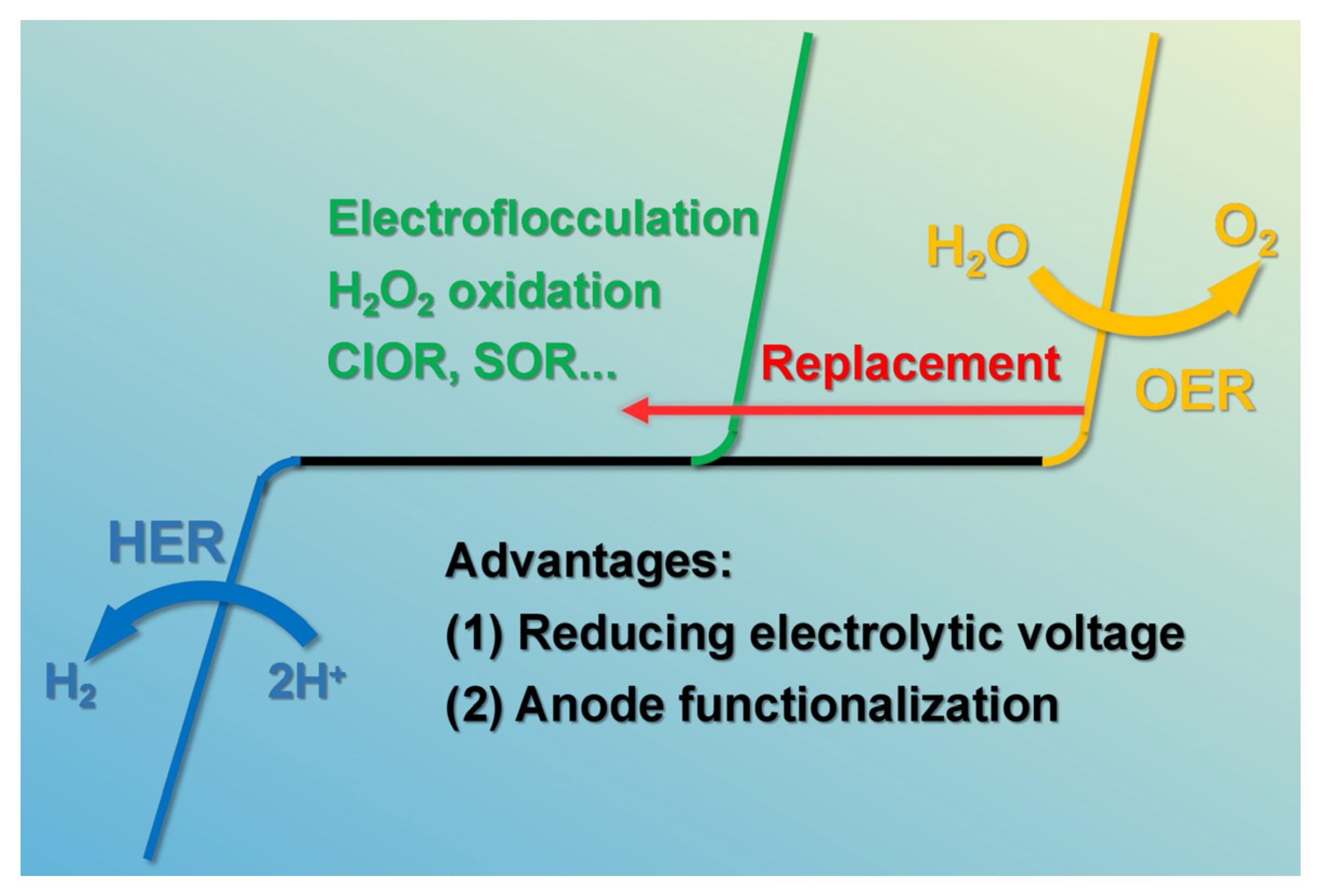
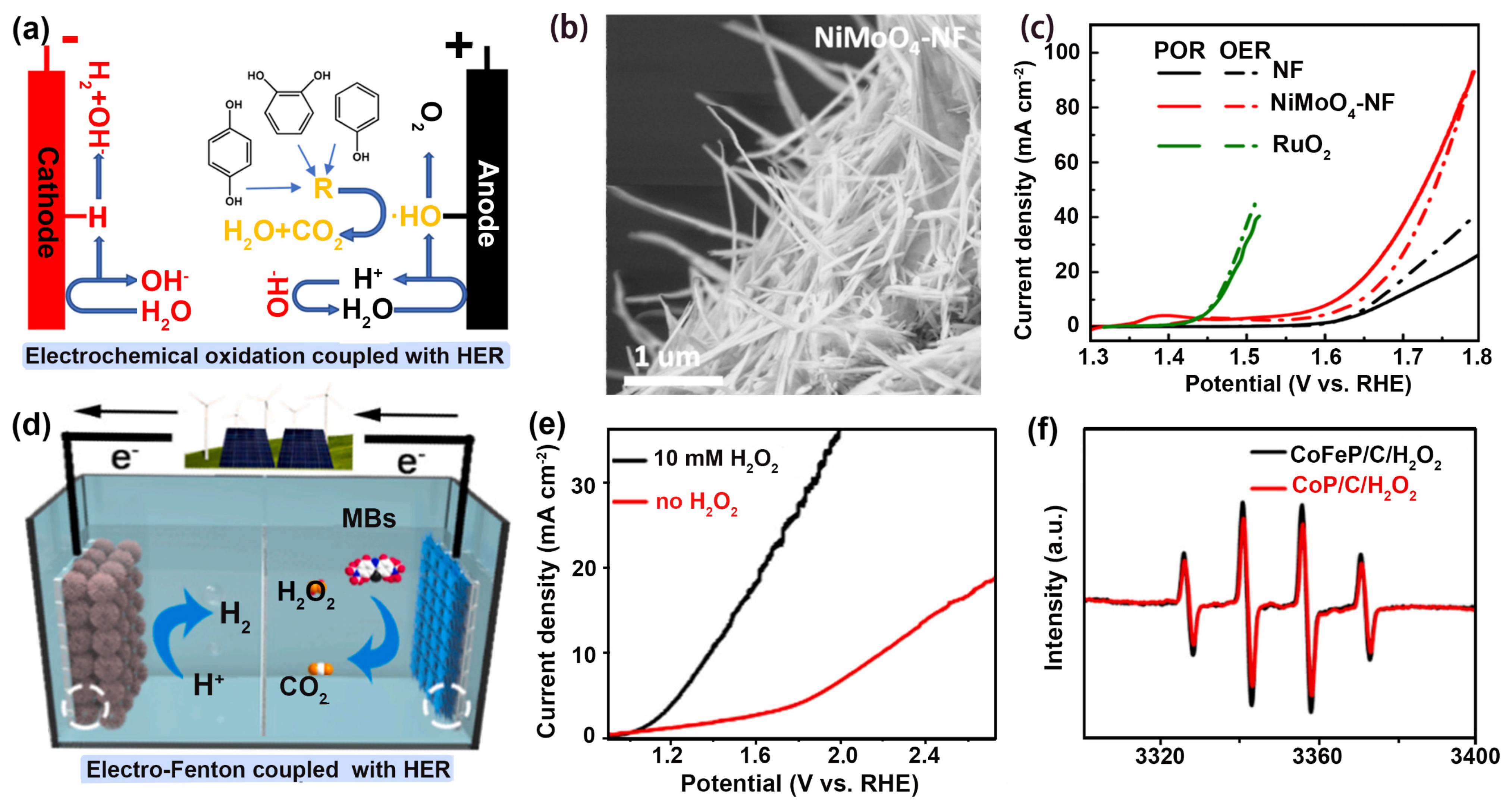
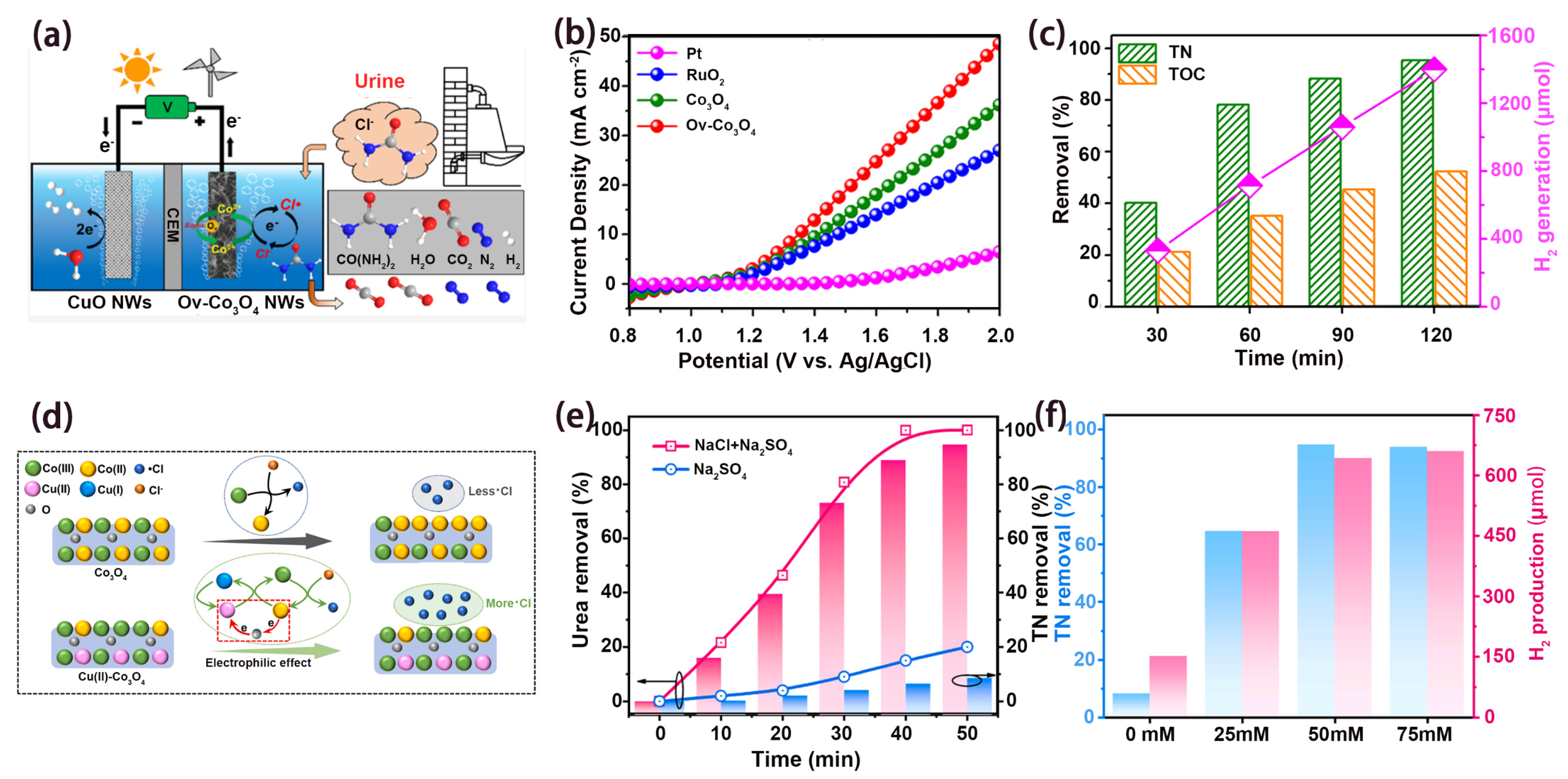
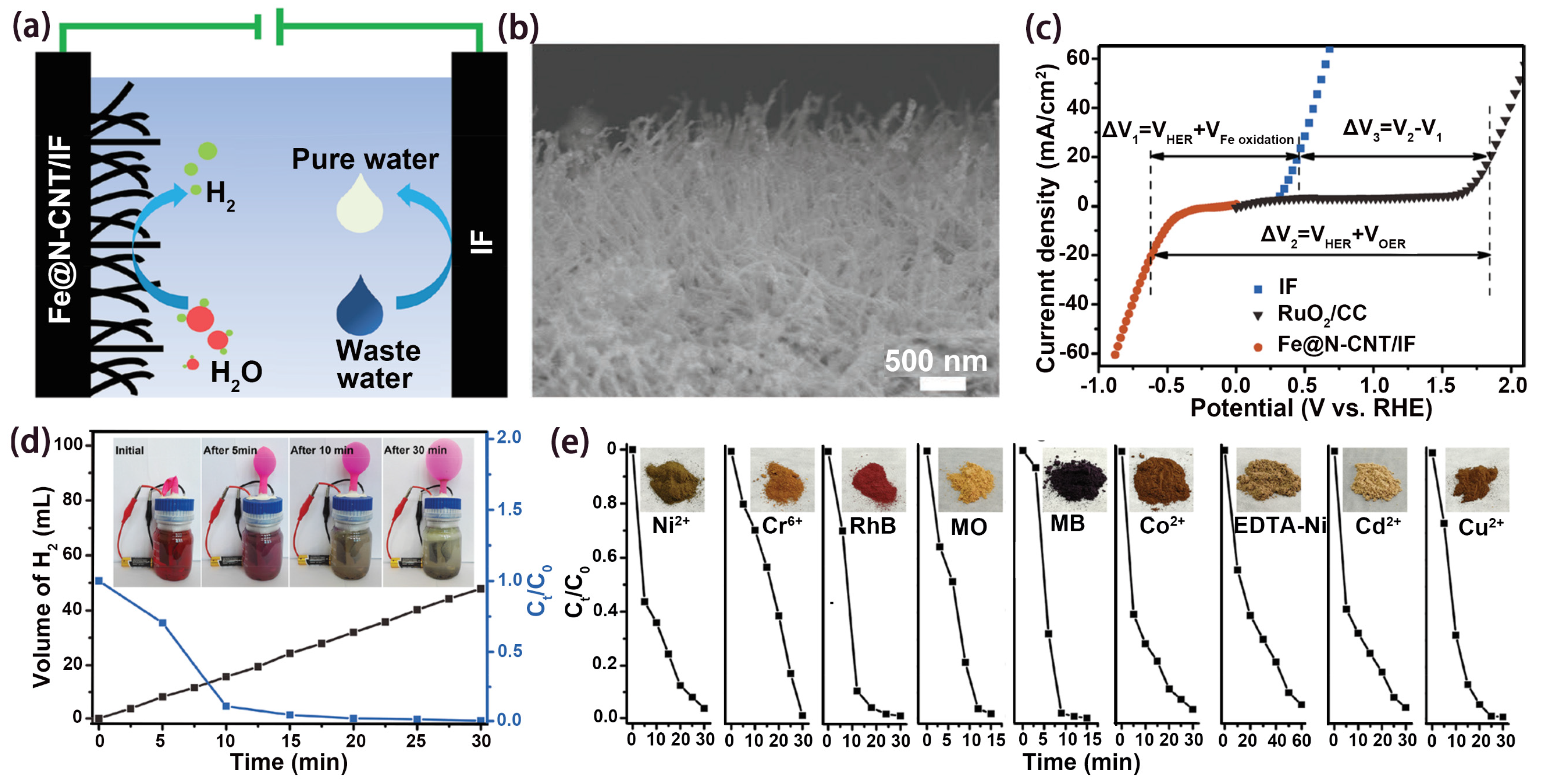

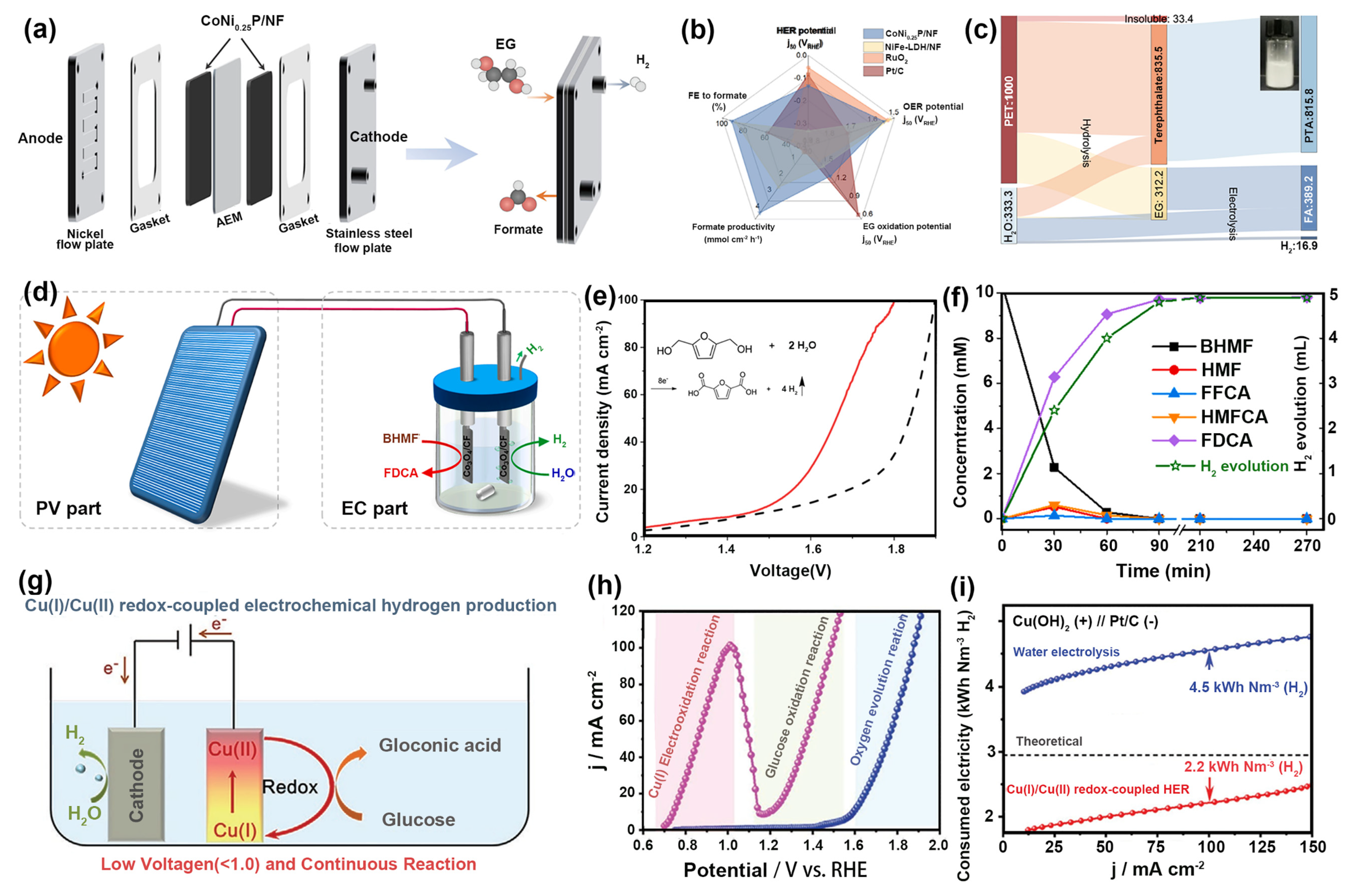
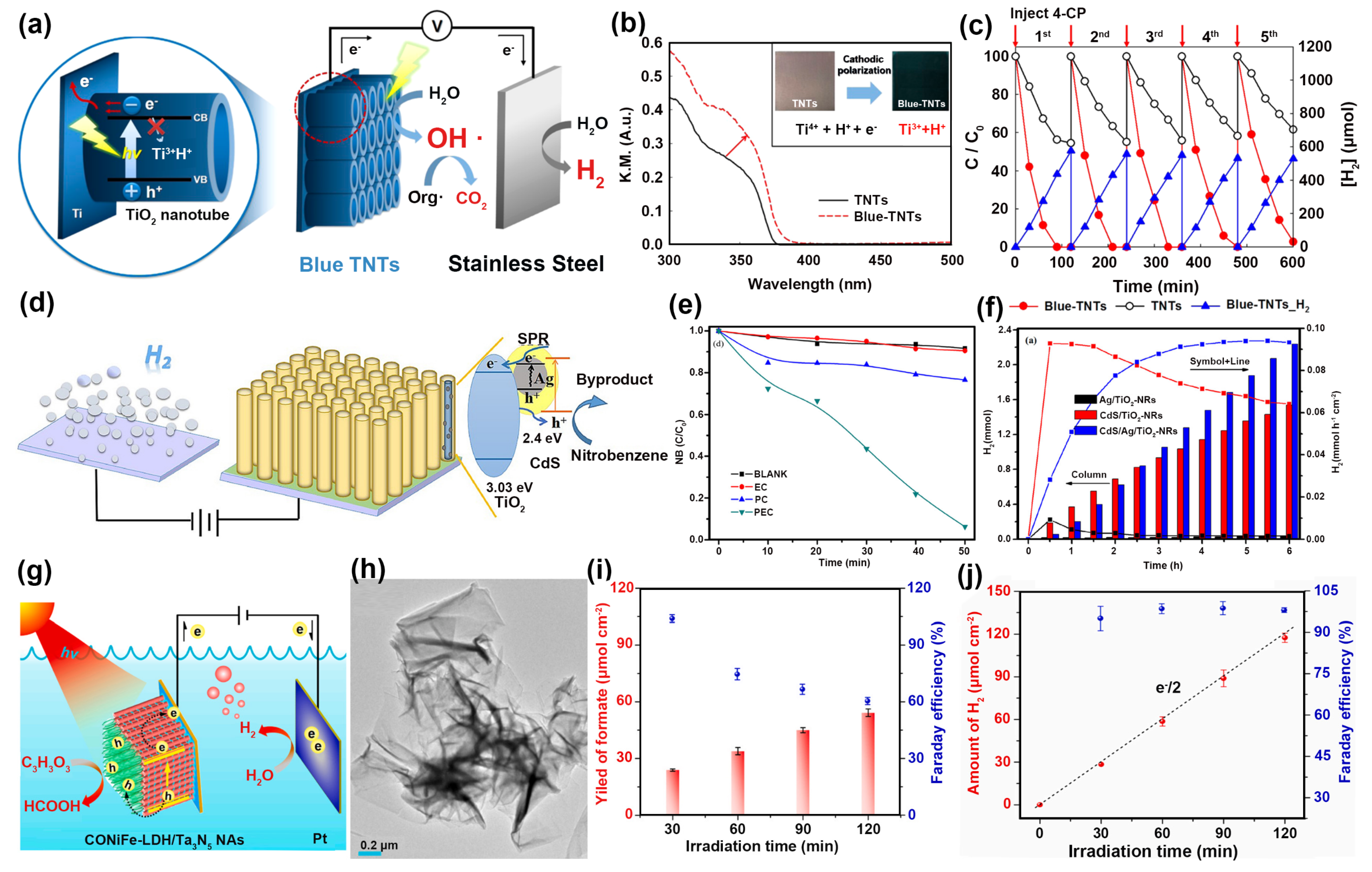
Disclaimer/Publisher’s Note: The statements, opinions and data contained in all publications are solely those of the individual author(s) and contributor(s) and not of MDPI and/or the editor(s). MDPI and/or the editor(s) disclaim responsibility for any injury to people or property resulting from any ideas, methods, instructions or products referred to in the content. |
© 2024 by the authors. Licensee MDPI, Basel, Switzerland. This article is an open access article distributed under the terms and conditions of the Creative Commons Attribution (CC BY) license (https://creativecommons.org/licenses/by/4.0/).
Share and Cite
Huang, L.; Fang, C.; Pan, T.; Zhu, Q.; Geng, T.; Li, G.; Li, X.; Yu, J. Hydrogen Production via Electrolysis of Wastewater. Nanomaterials 2024, 14, 567. https://doi.org/10.3390/nano14070567
Huang L, Fang C, Pan T, Zhu Q, Geng T, Li G, Li X, Yu J. Hydrogen Production via Electrolysis of Wastewater. Nanomaterials. 2024; 14(7):567. https://doi.org/10.3390/nano14070567
Chicago/Turabian StyleHuang, Lijun, Chaoqiong Fang, Ting Pan, Qigang Zhu, Tiangeng Geng, Guixiang Li, Xiao Li, and Jiayuan Yu. 2024. "Hydrogen Production via Electrolysis of Wastewater" Nanomaterials 14, no. 7: 567. https://doi.org/10.3390/nano14070567
APA StyleHuang, L., Fang, C., Pan, T., Zhu, Q., Geng, T., Li, G., Li, X., & Yu, J. (2024). Hydrogen Production via Electrolysis of Wastewater. Nanomaterials, 14(7), 567. https://doi.org/10.3390/nano14070567








